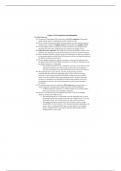Chapter 12: DNA Replication and Manipulation
12.1 DNA Replication
❖ The process of duplicating a DNA molecule is called DNA replication. The parental
strands separate and new complementary partner strands are made.
❖ The two strands of the parental duplex molecule separate, and each individual parental
strand serves as a model, or template strand, for the synthesis of a daughter strand.
❖ As each daughter strand is synthesized, the order of the bases in the template strand
determines the order of the complementary bases added to the daughter strand.
❖ Semiconservative replication- after replication, each new DNA duplex consists of one
strand that was originally part of the parental duplex and one newly synthesized strand.
❖ Half of the DNA molecules will have one heavy old strand and one light new strand and
an intermediate density, and half of the DNA molecules will have one light old strand and
one light new strand and a low density.
❖ The new daughter strands have opposite orientations, so that near the replication fork
the daughter strand in the bottom duplex terminates in a 3′ hydroxyl, whereas that in the
top duplex terminates in a 5′ phosphate.
➢ The strand that terminates in the 5′ phosphate cannot grow in the direction of the
replication fork because new DNA strands can grow only by the addition of
successive nucleotides to the 3′end. DNA always grows in the 5′-to-3′ direction.
❖ DNA polymerization occurs when the 3′ hydroxyl at the growing end of the
polynucleotide chain attacks the triphosphate group at the 5′ end of an incoming
nucleotide. As the incoming nucleotide triphosphate is added to the growing DNA
strand, one of the nucleotide’s high-energy phosphate bonds is broken to release the
outermost two phosphates, and immediately the high-energy phosphate bond in the
pyrophosphate is cleaved to drive the polymerization reaction forward and make it
irreversible.
❖ The polymerization reaction is catalyzed by DNA polymerase, an enzyme that is a
critical component of a large protein complex that carries out DNA replication.
➢ All DNA polymerases synthesize a new DNA strand from an existing template.
Most, but not all, also correct mistakes in replication.
❖ Because a new DNA strand can be elongated only at the 3′ end, the two daughter
strands are synthesized in different ways.
➢ The leading strand has its 3′ end pointed toward the replication fork, so that as
the parental double helix unwinds, nucleotides can be added onto the 3′ end and
this daughter strand can be synthesized as one long, continuous polymer.
➢ The lagging strand grows away from the fork and forms a stretch of single-
stranded DNA of a few hundred to a few thousand nucleotides, depending on the
species. Then, as the parental DNA duplex unwinds further, a new daughter
strand is initiated with its 5′ end near the replication fork, and this strand is
elongated at the 3′ end as usual.
, ➢ The short pieces in the lagging strand are called Okazaki fragments.
❖ Each new DNA strand must begin with a short stretch of RNA that serves as a primer, or
starter, for DNA synthesis. The primer is needed because the DNA polymerase complex
cannot begin a new strand on its own; it can only elongate the end of an existing piece of
DNA or RNA.
❖ The primer is made by an RNA polymerase called RNA primase, which synthesizes a
short piece of RNA complementary to the DNA template and does not require a primer.
❖ Once the primer has been synthesized, the DNA polymerase takes over and elongates the
primer, adding successive DNA nucleotides to the 3′ end of the growing strand.
❖ Because the DNA polymerase complex extends an RNA primer, all new DNA strands
have a short stretch of RNA at their 5′ end.
❖ When the growing fragment comes into contact with the primer, a different DNA
polymerase complex takes over, removing the RNA primer and extending the growing
fragment with DNA nucleotides to fill the space left by removal of the RNA primer.
When the replacement is completed, the adjacent fragments are joined, or ligated, by an
enzyme called DNA ligase.
❖ Many other proteins and enzymes work at the same time to ensure accurate and
efficient synthesis of the daughter strands.
➢ Topoisomerase II, works upstream from the replication fork to relieve the stress
on the double helix that results from its unwinding at the replication fork.
➢ Helicase separates the strands of the parental double helix at the replication
fork.
➢ Single-strand binding protein binds to these single-stranded regions to prevent
the template strands from coming back together.
❖ The DNA polymerase complexes for each strand stay in contact with each other, with
the lagging strand’s polymerase releasing and retrieving the lagging strand for the
synthesis of each new RNA primer.
❖ The positioning of the polymerases is such that both the leading strand and the lagging
strand pass through in the same direction, which requires that the lagging strand be
looped around. The 3′ end of the lagging strand and the 3′ end of the leading strand are
elongated together, which ensures that neither strand outpaces the other in its rate of
synthesis.
❖ When DNA damage occurs during replication, the rate of synthesis slows down so that
the DNA can be repaired. If synthesis of one strand slows down to repair DNA damage,
synthesis of the other strand slows down, too.
❖ Most DNA polymerases can correct their own errors in a process called proofreading,
which is a separate enzymatic activity from strand elongation (synthesis).
❖ DNA polymerase can correct errors because it detects mispairing between the template
and the most recently added nucleotide. Mispairing between a base in the parental strand
and a newly added base in the daughter strand activates a DNA-cleavage function of




